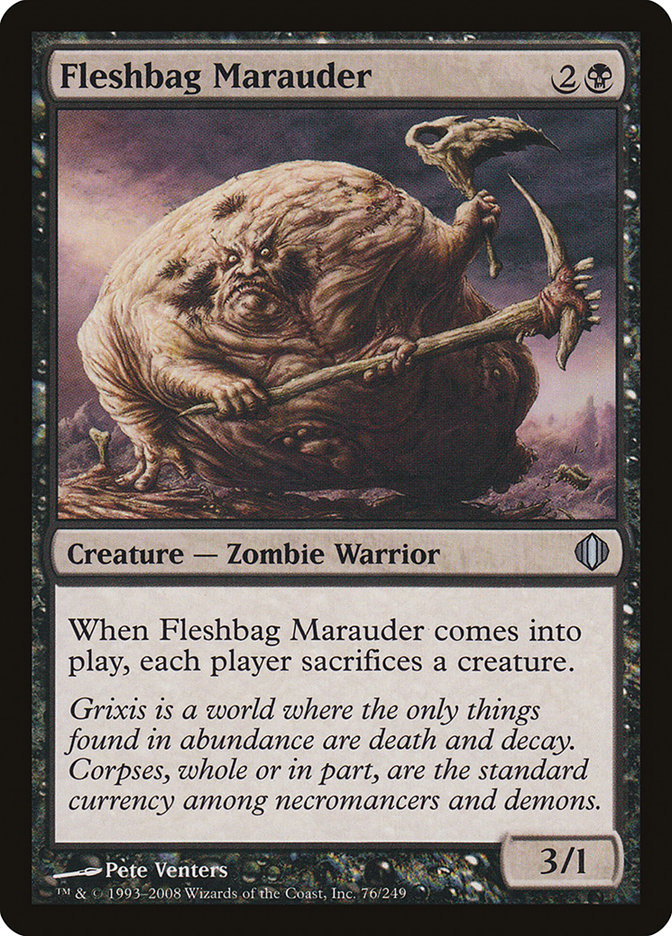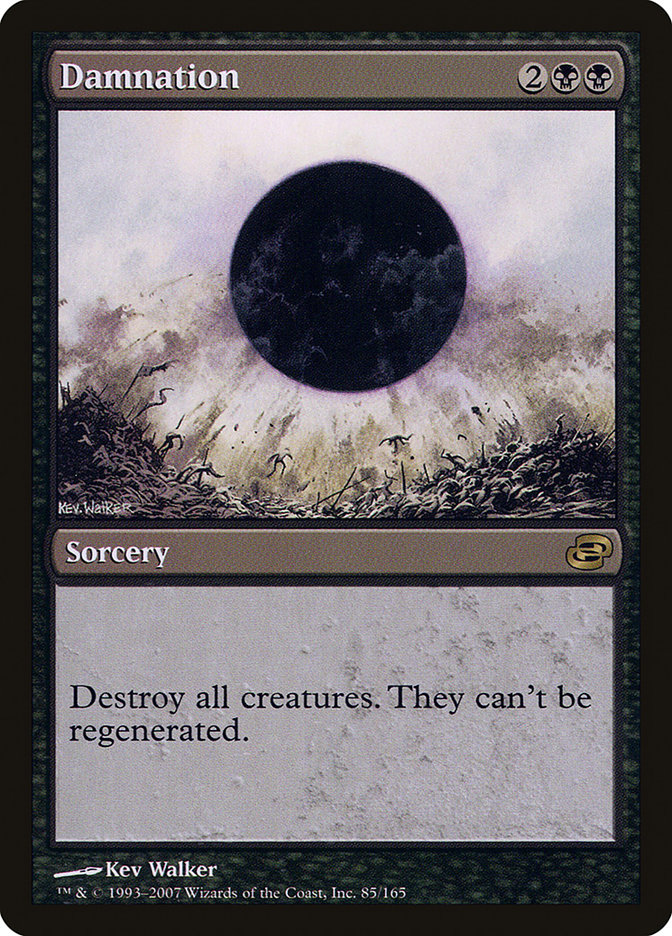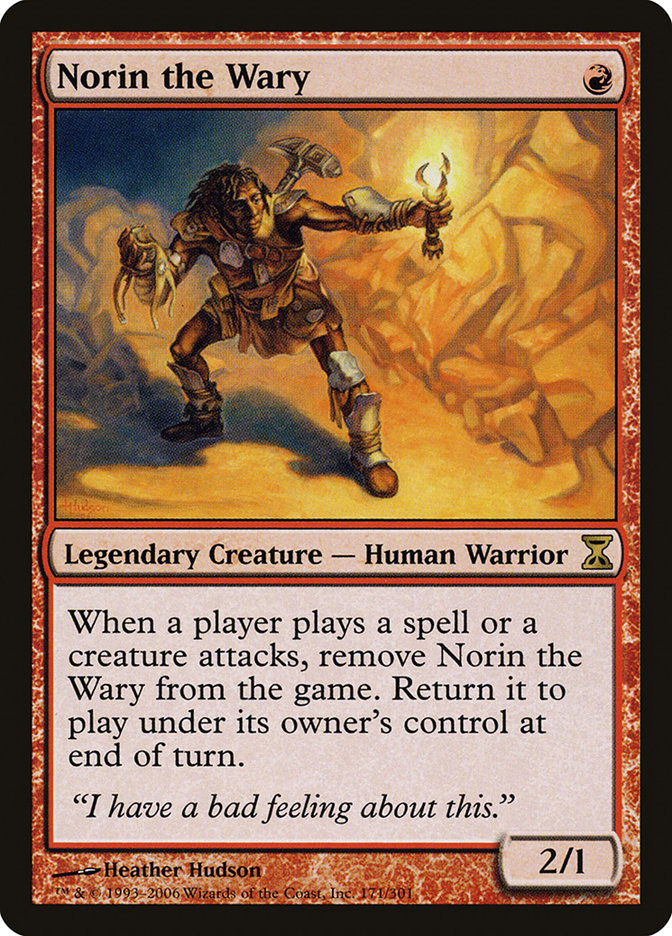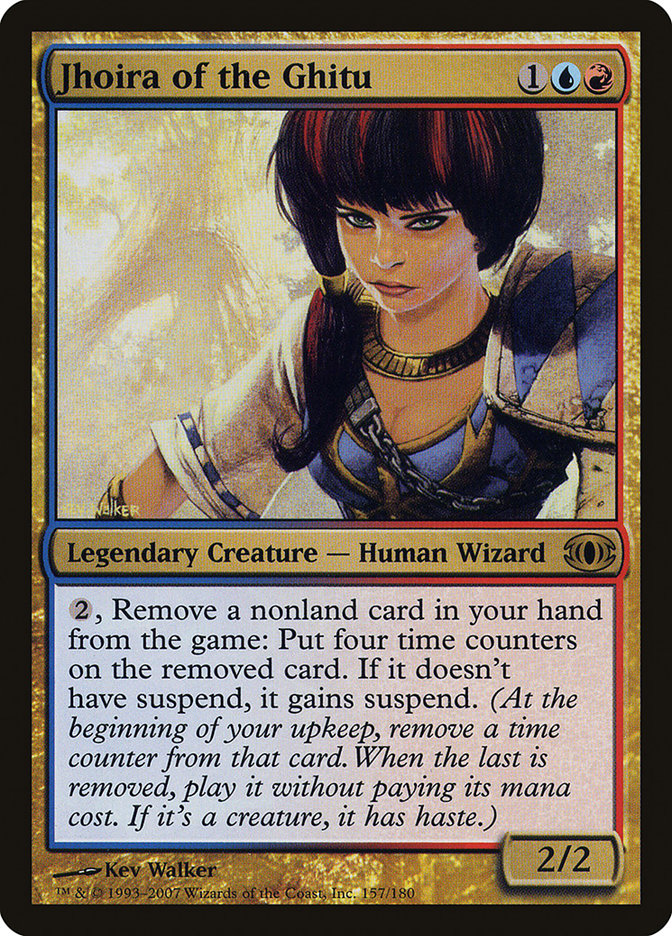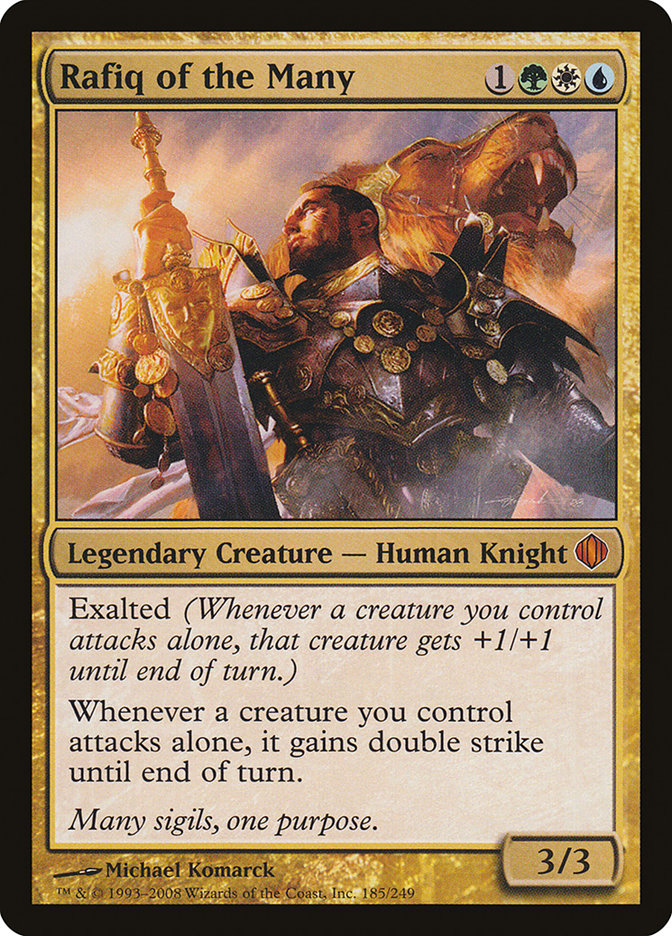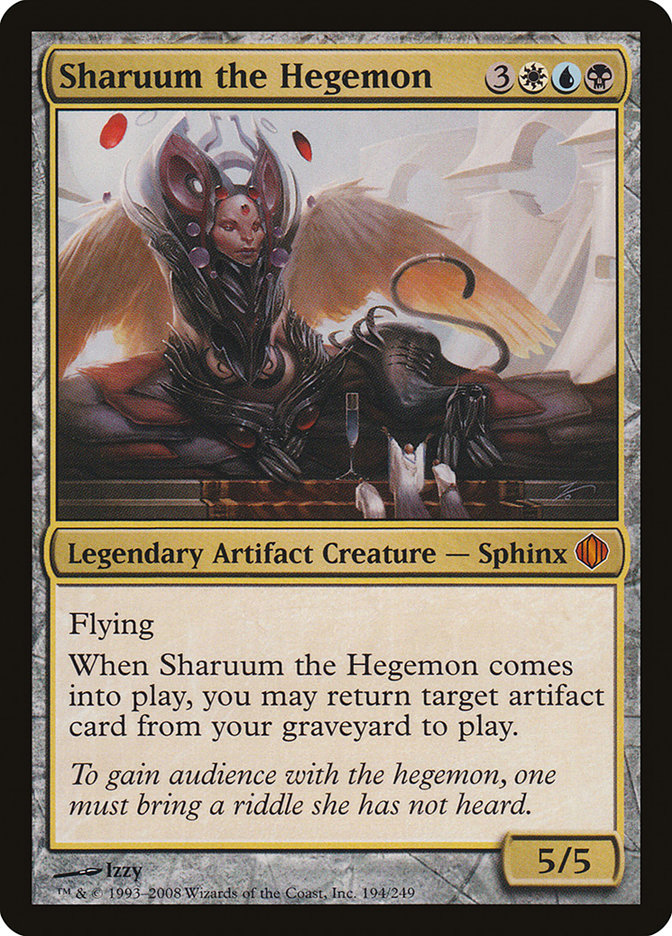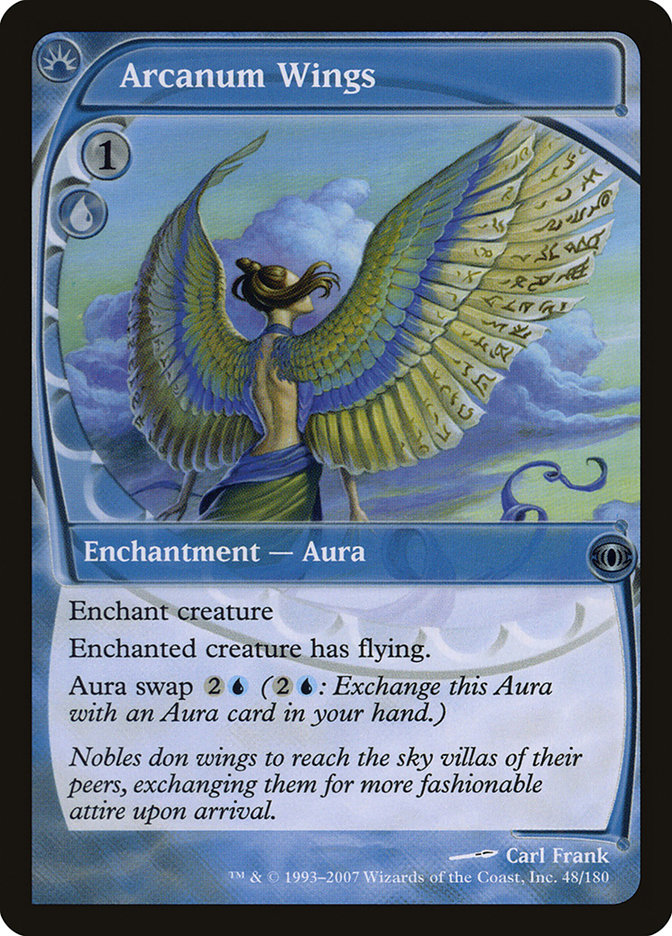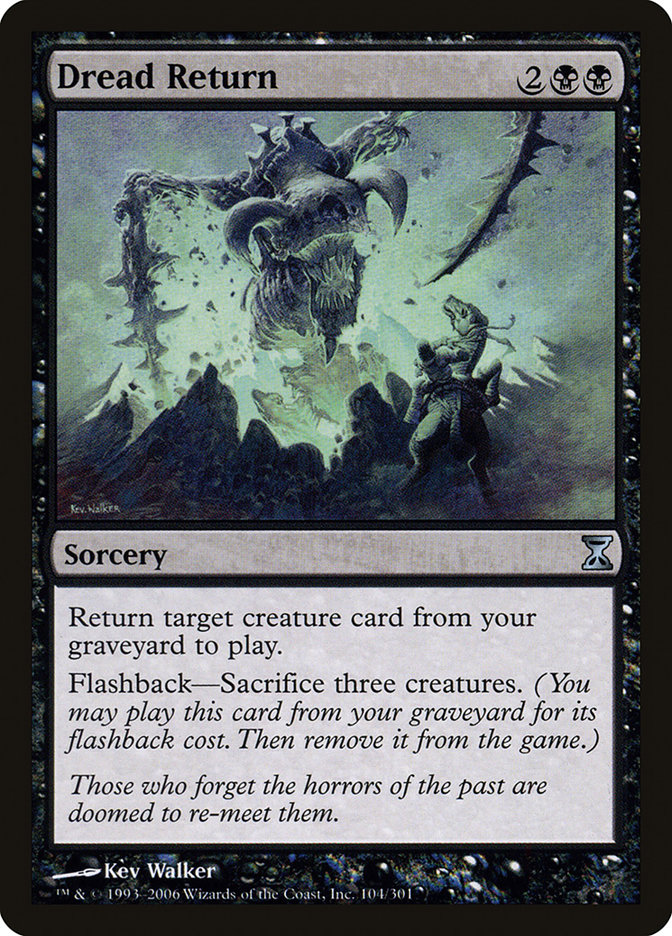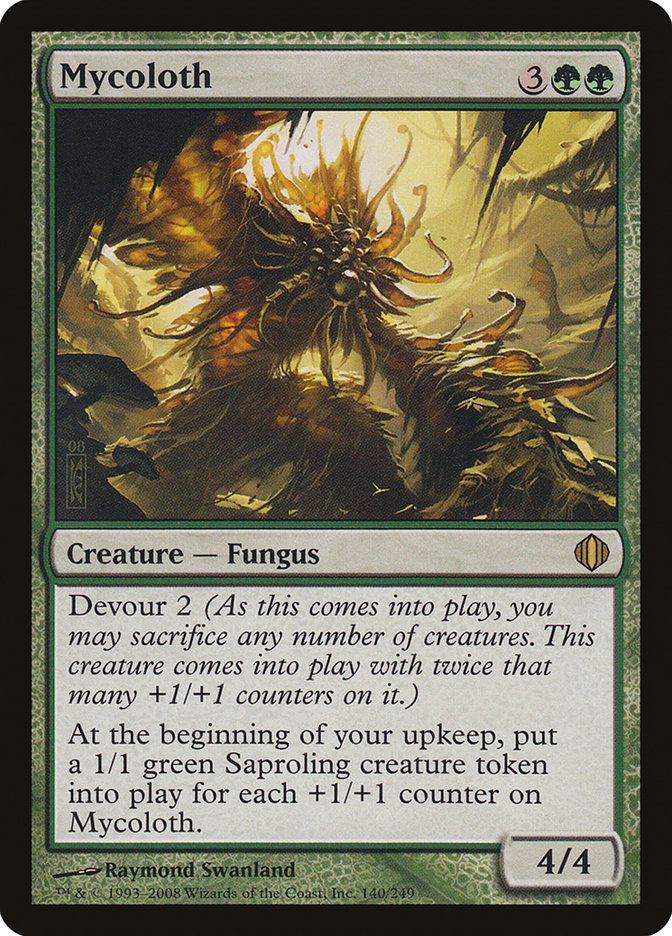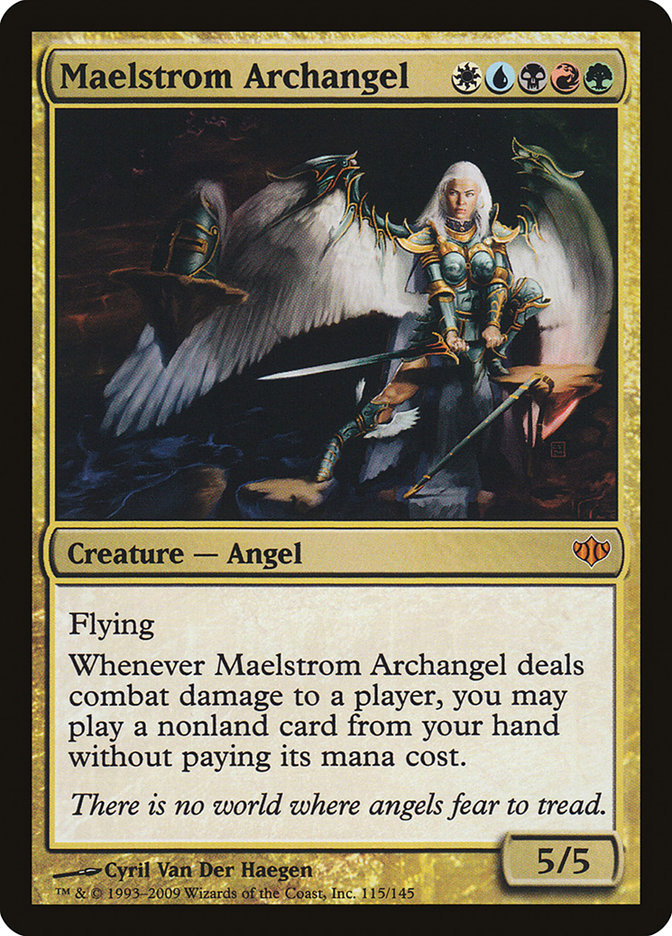If you’re new to Magic, I can’t imagine a worse place to pick up the game than with the Commander format. Commander is a collection of the strongest and quirkiest cards across the vastness of Magic’s card pool that would leave any new player drowning in a sea of disparate mechanics, confusing rules text, and unclear references to a past part of the game they’ve never experienced. I’m pretty sure this was the exact design ideology behind Time Spiral block.
Time Spiral block tells the story of temporal fissures opening and closing throughout the plane of Dominaria, as remnants of the past and some visions of the future spill out into the multiverse and create havoc within the fabric of the Magic universe. This story allowed the designers to create a nostalgic Snickers bar of a block filled with a chewy nougat center of old mechanics, sprinkled with the salted peanuts of flavor text callbacks, and glazed over with a semi-sweet chocolate layer of inventive strategies.
Time Spiral block is a love letter to the players that have stuck with the game for multiple years and just like the Commander format rewards them with cards using or combining old mechanics in new and ingenious ways, breathing life into areas of the game that were sealed off like a King Tut’s tomb.
Commander players love multicolored cards more than Patrick Chapin loves Jace, the Mind Sculptor and for the same reasons—they offer increased utility and power for a low cost in a format made to cast them. Shards of Alara block brought players to a world torn into five separate three-color fragments that paired each color with its allied colors and filtered these allied colors through their own unique ecosystems called Jund, Bant, Esper, Grixis, and Naya.
Each ecosystem brought a new mechanic to its shard, including the unique colored artifacts in Esper that was spoiled in Time Spiral block. These shards then collapsed into each other, reforming the plane of Alara and bringing a set entirely composed of multicolored cards called Alara Reborn. Just like in Ravnica block, Shards of Alara block will be remembered for giving a face and name to the allied-color triplets and fantastic mana fixing for people who want to cast all those savory polychromatic spells.
Let’s take a quick look at the bracket and see where we’re at in our Battle Of The Blocks:
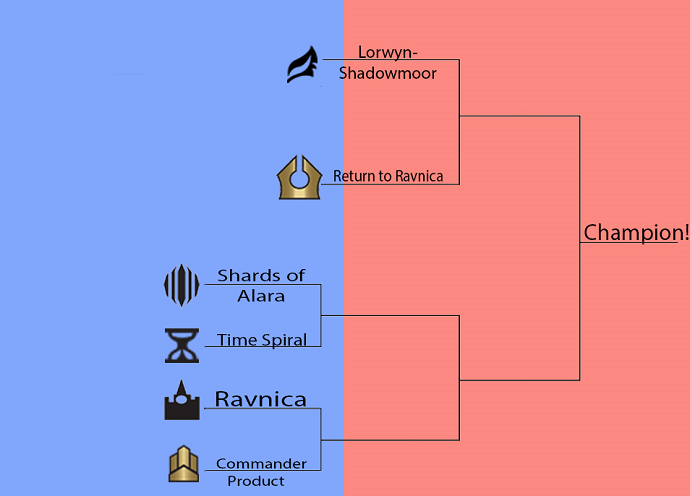
There are a bunch of multicolored blocks in the Top 8 and one already in the Top 8. I wonder if Shards can make it in there with them? Remember, these battles are to decide which block contributed the most to Commander, not the best block in all of Magic. They will be compared in the usual five categories: Staples, Commanders, Strategies, Flavor, and The Bad.
Staples
Five Notable Staples From Shards Of Alara Block
1) Path to Exile
2) Tri Lands
3) Martial Coup
4) Maelstrom Pulse
5) Fleshbag Marauder
The Staples section is commonly populated with singularly powerful spells with the ability to sweep, ramp, or draw extra cards, and Shards of Alara is no different. Exile effects have reached peak importance in the Commander format as the splashy indestructible Gods from Theros block have arrived on the main stage accompanied by a resurgence in graveyard recursion strategies in the format. To combat these resilient creatures, Path to Exile matches Swords to Plowshares as the most efficient way to exile a creature without an incredibly large downside. Fleshbag Marauder also combats this indestructible menace by forcing everyone to sacrifice a creature—plus he plays well in a recursion strategy, making him a multitasker for Commander deck designers.
Alton Brown’s motto of "never buy a unitasker" can be applied to Commander and is represented with cards like Martial Coup and Maelstrom Pulse. With the craziness that happens in each Commander game, cards that have multiple functions are of chief importance to keep up with the varied spells opponents are slamming onto the board. Maelstrom Pulse shirks the unitasker covering of its big brother Vindicate and receives the role of a multitasker through its ability to destroy any nonland permanent and its usefulness against token decks. Martial Coup would also make Alton Brown proud through its ability to sweep an entire board and be a win condition, a unique set of qualities that is extremely rare in Magic.
Five Notable Staples From Time Spiral Block
1) Damnation
2) Gauntlet of Power
3) Coalition Relic
4) Return to Dust
5) Venser, Shaper Savant
In a block living in the past, Planar Chaos finally took Magic’s color philosophy into the future and delivered the sweeper effect players had been clamoring after for years in Damnation. The fact that a black four-mana Wrath of God didn’t get printed until 2007 is baffling. Forcing the color that kills things for a living to jump through hoops with cards like Mutilate and Decree of Pain made the arrival of Damnation a breath of fresh air for players who love their Magic with a tinge of darkness.
Gauntlet of Might is another original Alpha card whose facsimile made this list. Time Spiral block sidestepped the reserved list and brought the power to the people in the minting of Gauntlet of Power. With the prevalence of monocolored decks that love extra mana and a slight boost in power, Gauntlet of Power isn’t going to leave the Commander format for a very long time.
Verdict: Shards of Alara puts up a great fight with its slew of Alton Brown-approved multitaskers, but the powerful spells from Time Spiral block knock Shards of Alara block away in this section and win this round.
Commanders
The last time we went over Time Spiral block I made sure to focus on how important the Planar Chaos Dragons were to the Commander format. These wedge-colored dragons were the only way to play those colors for years until the Commander 2011 product. Stepping away from the flying 6/6s for six, Time Spiral block has more than the still-popular wedge Dragons to offer players looking for a general in Commander:
Jhoira was the bogeymen of the Commander format because of her unique suspend ability until people learned that turn 7 Eldrazi and Decree of Annihilations were hard to win against and began to immediately kill the deck whenever it came anywhere near a Commander table. Norin the Wary is the absolute embodiment of shenanigans in Commander, with his frustrating blinking in and out of existence triggering cards like Warstorm Surge, Confusion in the Ranks, and Genesis Chamber. The generals from Time Spiral block are varied and filled with sweet abilities like Scion of the Ur-Dragon and Endrek Sahr, but space is limited and there’s another block to delve into.
Shards of Alara block printed five of the most popular generals in Commander. Rafiq of the Many embodies the Voltron deck concept that builds itself around a single creature going the distance and thrashing each opponent. The only thing Rafiq of the Many needs is a Finest Hour to deal the total 21 general damage, but decks built around this impressive Knight are filled to the brim with Auras and Equipment to give the greatest chinstrap from the plane of Alara the evasion he requires to win the game.
Sharuum the Hegemon calls the shard of Esper her home and is the most popular artifact general by a country mile. Her reanimation effect is unique among Esper generals and lends itself to a deck that can create some explosive interactions from the general zone and is resilient to the large amount of artifact removal in the format. The others—Kresh the Bloodbraided, Uril, the Miststalker, and Thraximundar—all call Alara home and are popular generals in the Commander format.
Verdict: The popular generals from Shards of Alara have attached a solid face to the shards they are from just like the Planar Chaos Dragons did with the wedges. Each of these blocks has an insanely deep amount of playable commanders, but I have to give it to Shards of Alara block because of the prevalence of its legends in the current Commander format.
Strategies
Going back and exploring Time Spiral block reveals that it brought more than storm cards, Slivers, and blink effects to Commander. Enchantment decks grabbed a draw engine in Mesa Enchantress, and the Auras Daybreak Coronet and Arcanum Wings shore up any enchantment-based strategy. A quick look at Arcanum Wings reveals the unbridled power in the Aura swap mechanic that can transform this small blue Aura into a Pollenbright Wings or even an Eldrazi Conscription!
The Legacy-playable Dread Return is a great fit for most reanimation decks, with Living End turning the graveyard inside out at the exact moment you need it to take over the game. Control decks also made out like bandits from Time Spiral block, stealing Teferi, Mage of Zhalfir; Mystical Teachings; Careful Consideration; and the eternally maddening Frozen Aether. There is one more tribe that got some love from Time Spiral: the Timmy favorite Dragons! A solid five-color general for the flying monsters of choice in Scion of the Ur-Dragon and creatures like Bogardan Hellkite and Scourge of Kher Ridges have delightfully filled out the top of an already full mana curve.
When looking at Shards of Alara block, the mechanics are where a large amount of the fun for Commander comes from. The cascade mechanic has been a favorite within the Commander scene because of its slot machine-like randomness that leads to praying for the double (if not triple) spell flip. The scavenge mechanic is an outlet for decks that are looking to utilize a sacrifice-based approach to a game of Commander. These creatures, like Mycoloth, Tar Fiend, and Skullmulcher, turn worthless Plants, Saprolings, and elementals into more cards or even more creatures.
Although domain never took off as the true path for a five-color deck, this block brought a ton of incentives for players looking to stretch their mana bases into the stratosphere. Spells like Conflux, Maelstrom Archangel, and Progenitus dangle like carrots in front of Commander players and goad them into transforming their 100 cards into a polychromatic lottery ticket. Shards of Alara block is also where people can turn to when they want to throw their creatures with cards like Fling or Rite of Consumption because the trio of Kresh the Bloodbraided, Lord of Extinction, and Soul’s Fire await the intrepid explorer who decides to visit Alara.
Verdict: Time Spiral block comes out ahead of Shards of Alara block here because of its bold card design creating unique spells that fit the many strategies of Commander like a glove.
Flavor
Neither of these blocks does a good job in telling an actual story over the course of their three acts. Shards of Alara block fails in communicating the significance of Nicol Bolas and his involvement with the Maelstrom and the coming together of the five separated shards. This leaves the player lost as to why Alara Reborn is a full multicolored block and the purpose of the flavor-jarring five-color spells like Fusion Elemental.
Time Spiral block also fails at communicating any semblance of its temporal-based narrative. Even if it is pretty cool that Leviathans are coming out of time portals, people would like to know why this kind of ridiculousness is happening. The reason a combining story is so important in Magic and the reason I’ve dedicated and entire section to it is that it allows the player to connect with the game and understand what in the world is going on in an incredibly advanced game. Trying to navigate your way through a story-less block is like reading a dictionary compared to a novel. Each book is just a collection of words, but the constant narrative in a novel leads to increased enjoyment.
Each block does excel at one thing when it comes to flavor. Time Spiral blocks’ endless callbacks to the past with cards like Viscid Lemurs and Timbermare dredge up old memories of past experiences, turning these cards from random dictionary definitions into story threads the player can hold on to. The layering of mechanics in cards like Sprout Swarm and Ichor Slick also invoke these nostalgic dreams by swirling together previous blocks into a new experience.
Shards of Alara block was successful in finally attaching an overarching theme, name, and place to each of the allied-colored wedges. Instead of saying a deck is blue, black, and white, its name is now Esper and immediately resonates with artifacts and control decks. These flavor triumphs eclipse these blocks’ abysmal storylines and allow them to not fall on their faces in this section.
Verdict: Although neither block truly succeeds in this section, Shards of Alara takes it by turning unlinked allied shards into places a player can visit and learn about.
The Bad
Neither of these sets has found their way on the Commander banned list, and their contributions to the format have been positive. Two generals stick out as small black marks in Rafiq of the Many and Jhoira of the Ghitu. These two generals are on every player’s kill-on-sight list because of the crazy things that happen the turn—or exactly four turns—after they land. A finely tuned Rafiq of the Many deck can easily kill a player with commander damage on turn 5. Jhoira of the Ghitu’s inclusion isn’t a shocker to anyone who has played against a powered-up build of this time lord. Her ability to suspend cards like Obliterate alongside Kozilek, Butcher of Truth turns an eleven-turn interactive game into a seven-turn race to kill the player who is about to annihilate the entire board.
Verdict: It isn’t a sin to create a general that’s a little strong. The format has corrected itself to include these generals by focusing on them early in Commander games. Neither block wins or loses.
Final Verdict
These two blocks produced a great battle, with each side taking categories away from the other. The important Commander category was won by Shards of Alara block, but it dropped both the Strategies section and Staples section to Time Spiral block. Let’s check the report card to see how these blocks fared against each other.
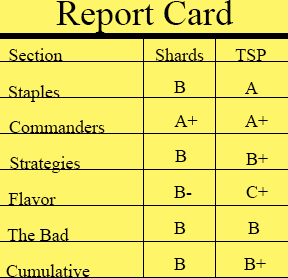
Time Spiral takes this Battle Of The Blocks and earns a score even with Return to Ravnica with a stellar collection of generals and staples for the format. Next week will feature Ravnica block going head-to-head with the Commander product for a spot in the Top 4!

